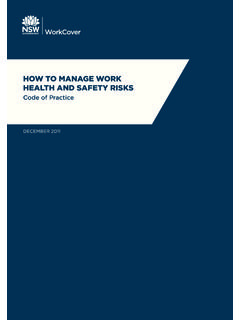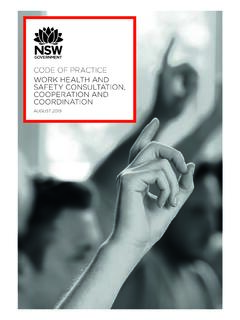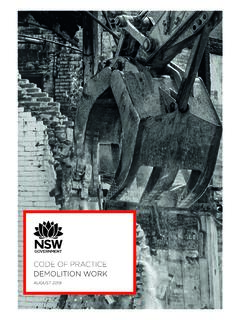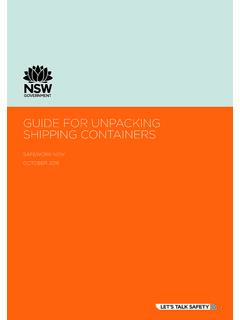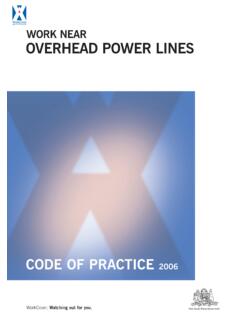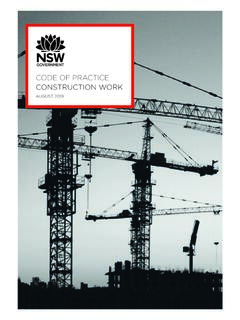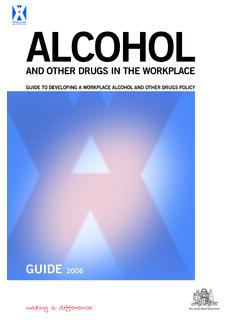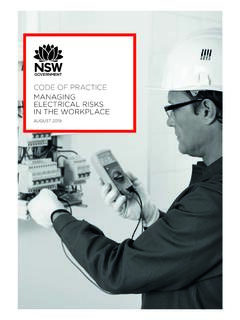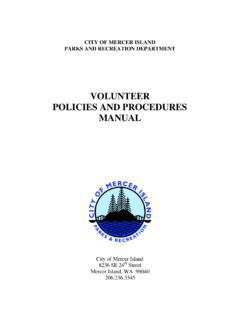Transcription of WHS FORM 03: WORK HEALTH AND SAFETY POLICY
1 WHS FORM 03: WORK HEALTH AND. SAFETY POLICY . We believe that the well-being of people employed at work, or people affected by our work, is a priority and must be considered during all work performed on our behalf. People are our most important asset and work HEALTH and SAFETY is everyone's responsibility. The SAFETY of the public is given equal priority to that of our workers. The objectives of this POLICY are to, as far as reasonably practicable: achieve a safe and incident free workplace consider WHS in project planning and work activities involve workers and subcontractors in the decision-making process through regular communication and consultation ensure workers and subcontractors identify and control risks in the workplace monitor and review the elimination or control of potential risks enhance workers' WHS knowledge through a program of education and training.
2 The success of our WHS management depends on: the commitment of all persons to achieve the POLICY objectives planning work activities, with due consideration given to WHS. undertaking the risk management process in an effective manner communication and consultation between our workers and subcontractors. We are committed to fulfilling the objectives of this POLICY and expect the same of all workers and subcontractors working on our behalf. / /. Name and position Signature Date HOUSING INDUSTRY SITE SAFETY PACK 7. CONSULTATION AND COMMUNICATION. Promote active participation of all workers in Record consultation and communication using: WHS decisions.
3 The record of toolbox talk (see WHS form 06). Consult with workers and give them the a site diary opportunity, encouragement and training any documents clearly recording WHS. to be involved in WHS matters affecting the meeting minutes. organisation and their own work. Consultation records should include at least the Consult with all your workers for example following information: directly through tool box talks or through date a HEALTH and SAFETY representative (HSR). Some principal contractors may ask that your location or workplace workers elect a HSR to participate in their names and signatures of people present consultative arrangements.
4 And consulted Matters for consultation may include: items or issues raised hazard and risk identification corrective actions to be undertaken and the people responsible for implementing control measures for managing hazards those actions. and risks the development of safe work method statements or risk assessments site SAFETY rules site induction changes to site conditions the welfare facilities the purchase of new or used plant and equipment or new substances and materials the development and review of SAFETY policies and procedures emergency procedures, covering: emergency contact details (including emergency services).
5 The location of a first aid kit emergency assembly points. 8 SAFEWORK NSW. RISK MANAGEMENT. Hazards versus risks Step 1: Identify hazards Hazards are different to risks. Inspect the workplace before starting the work and identify any hazards. When identifying A hazard has the potential to cause harm. This hazards, consider the physical nature of the can include substances, plant, work processes work environment, such as its height or confined and/or other aspects of the work environment. spaces in it, substances such as chemicals, A risk is the likelihood that death, injury or illness plant and equipment, energy such as electricity, might result because of a hazard.
6 Gas or induced heat, manual handling, noise, etc. You should consult with your workers and review all available information about hazards Risk management process and risks relating to your work. Make a list of all WHS laws require anyone in control of a the hazards you can find, including the ones you workplace or a workplace activity to identify know are already being dealt with, to ensure that any potential hazards, assess the risks nothing is missed. You could list these in WHS. associated with those hazards and,if necessary, form 04 Site-specific risk assessment.
7 Implement control measures to eliminate or minimise the risks. Step 2: Assess risks All persons must have an understanding of the Once a hazard has been identified, determine four step risk management process (Figure 1). how serious the risk is. Refer to Table 1 for Incorporate the steps into all work activities. If any more information. persons are concerned with the control measures used in a workplace activity, they should bring this to the attention of their direct manager. HOUSING INDUSTRY SITE SAFETY PACK 9. Table 1: Assessing the risk High Medium Low Potential death, permanent Hospitalisation or medical Hazard that has the RISK disability or major structural treatment, potential potential to cause persons failure/damage.
8 Temporary disability or minor to require first aid. structural failure/damage. Cease work immediately. Implement suitable controls Review task and reinforce Review task/situation/ as soon as practical. control measures where condition. Task/situation/condition to applicable. ACTION Additional risk controls be reviewed and reinforce REQUIRED and must be documented control measures where and implemented. applicable. Ensure all parties are aware of risk control. Step 3: Control the risks Develop and decide on a suitable control measure that will ensure that the hazard is either eliminated (where reasonably practicable) or reduced to its lowest possible level using the hierarchy of risk controls', in line with Table 2.
9 A combination of controls may be the most effective. Table 2: Hierarchy of controls Use personal Eliminate Substitute Isolate Engineering Administrative protective equipment Remove the Replace the Separate Structural or Reduce Last line of defence, risk, process risk with a less the people design change exposure to the worn by workers. or task. hazardous from the to the working hazard through Selected PPE must material, hazard or environment, procedural be fitted correctly process the hazard equipment or instructions, and maintained and or plant. from the work process.
10 Training, used in accordance people. signage or with manufacturer's permits. instructions. Examples Examples Examples Examples Examples Examples Removal of Fibreglass Fencing, Edge SWMS, SAFETY glasses, gloves, trip hazard, insulation for barricades protection, signage, hardhat, harness. removal of non-fibrous or removing lock out permit, training, asbestos, insulation, lead people from devices, tagging, working at based paint for the work guards on inspection. heights. lead free paint. area. rotating parts. Best Worst Ensure that the risk control measures you have decided on are in place prior to the activity being undertaken.
